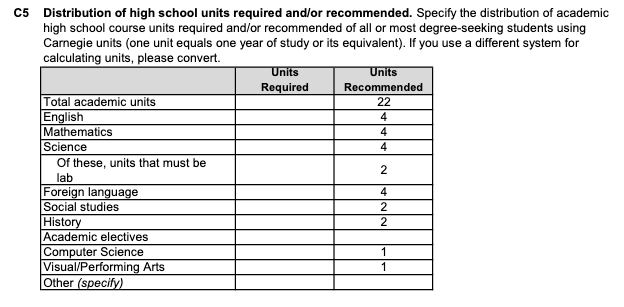U.S. News Best Colleges Rankings Considerations
Last Updated on September 23, 2025 by Jill Schwitzgebel

This year, the U.S. News list covers 1700 (an increase of 100+ from last year) colleges and universities, broken down into close to fifty different types of lists, some general and some more specific. They evaluate what they consider to be “up to” 17 measures of academic quality, down from 19 last year (they combined some measures). There is more stability this year, as the US Dept of Education did not update their data on the College Scorecard for analysis.
The Methodology
Their rankings all originate with a survey which gets distributed to all eligible colleges (colleges that award at least bachelor’s degree, not considered to be “highly specialized” and are regionally accredited). Colleges then self-report their own data on the survey. Once again, not all colleges that received the survey, completed it, though more did this year than last (up from ~66% to 79%). But, 99 of their top 100 nationally ranked universities did complete it. And if you’re wondering how seriously colleges take the U.S. News rankings, you can look at their strategic plans. At 100 of the largest universities in 2021, 25% of them mention these rankings in their current strategic plan. Since then, some have achieved their goals. Rumor has it that some universities actually have an employee just dedicated to working on this survey, as it is quite detailed.
U.S. News then goes back to cross check the data they have been given, using various other sources. The methodology and weighting process that they use is long, but can be found here, if you’re interested. In fact, I would recommend reading methodology of ANY college rankings list you’re consulting. This methodology is why you’ll note that various publications all differ in their order of their rankings. It all just depends on the factors that they are using for evaluation and how much weight they give to each of them.
Factors U.S. News specifically considers include things like selectivity in admissions, reputation among other college academicians and among high school guidance counselors, and graduation rate. They weight each factor differently. For instance US News continues to weight reputation among peer institutions fairly heavily. One major criticism recently is how heavily they weight SAT and ACT scores, especially given that recently, the majority of colleges are now test-optional. In fact, last year, they increased the weight given to 5%, for colleges where more than 50% of incoming students reported scores. They also carry over last year’s increased focus on student outcome measures such as student retention, graduate indebtedness and post-graduate earnings compared to the typical high school graduate.
The ranking methodology for the national universities list includes four indications relating to faculty research, that are not used in ranking colleges in the other categories. And Regional colleges North were ranked without using SAT/ACT scores, due to not having enough data.
A valid criticism that has been leveled at this publication’s rankings is that they have become so popular that some colleges appear to be making their decision about whether or not to remain test-optional or test-blind based on how U.S. News treats those categories. My own pet peeve is how heavily they weight the peer assessment survey (20%!). Professors and administrators really can’t claim to know the strengths of 1,700 colleges across the country – and in fact only 31% of them even responded to the survey again this year! Yet it’s given outsize consideration in this rankings list. There’s a good chance that a dean in Maryland may not really know much at all about a small college in Washington state.
Some schools that complete the survey by U.S. News don’t even make their published list. The reasons for that vary. Some schools are so specialized in their discipline that they are ineligible and others are too small. Some didn’t have six year graduation rates for first-time students available.
How Much Should I Care about Rankings?
There is no easy answer to that question. It is similar to the question “What is a good SAT score?” The answer will always be, “That depends on the student and their goals.” These rankings are simply quantitative information about a school and can’t give a student information about what a college is really like; what it feels like to be on that campus. So it’s important to not just look at a school’s ranking. It’s important to visit campus whenever possible, talk to students, ask questions, gather information about the school from as many sources as you can find.
The U.S. News and World Report rankings are so popular that you can bet that the schools that scored well in any of the 50 categories will showcase it in their marketing materials. But, they are really just one tool in your college search process. Ultimately, I would say the ranking of a school that you’re interested in is just one more data point to consider among a school’s many other characteristics. Just because a college happens to be number one on a rankings list doesn’t automatically make the school right for your student. Besides, that number one may change next year, anyhow.
See also: Finding a College Fit
Rankings Changes
One thing that has become obvious over the years is that there is relatively little movement in the upper categories of the national rankings. We are talking about highly selective schools and they have a vested interest in maintaining their place on these lists. So, absent major change in the way they are evaluated, large institutions are not going to move much. These schools do surely take note of a change in either direction though. Occasionally two of them will switch places or one school will make steady progress up in the rankings (looking at you, FIU!). These are reasons why it’s important to remember that this listing is best considered relatively over time. A lower rank from last year does not mean that a school’s quality suddenly declined in one year. It could be that the methodology being used was changed ever so slightly, resulting in a different result than years past. Now, if there is a downward trend for a school over several years, that may be worth investigating.
Perhaps the biggest change to this list in recent years, was when they changed the way they consider the SAT and ACT in rankings back in 2021. As colleges have become overwhelmingly test optional, the methodology regarding test scores has also had to change. They assess schools using the median SAT/ACT scores of entering students, if they were reported by half or more of new students. If not:
“For schools reporting SAT/ACT scores on less than 50% of both their fall 2024 and fall 2023 entering classes – including test-blind schools – they were not assessed at all on standardized tests. Instead, for those schools we increased the weights of graduation rates an additional five percentage points, from 16% to 21%. This substitute was chosen because it was the statistic from the rankings formula that correlated closest to standardized tests”
Rankings
Here are the top results in a few categories. “A+ Schools for B students”(bottom) is usually a favorite.
For the full rankings, go to U.S.News and World Report Best College Rankings Online. And once again, I’ll remind you, there are very few differences between number one and number 10…or even number 20! The fact that there are frequent ties among multiple schools, tells you how very similar they are.
National Universities
1. Princeton University
2. Massachusetts Institute of Technology
3. Harvard University
4. (tie) Stanford University, Yale University
6. University of Chicago
7. (tie) Duke University, Johns Hopkins University, Northwestern University, University of Pennsylvania
National Liberal Arts Colleges
1. Williams College
2. Amherst College
3. US Naval Academy
4. (tie) Swarthmore College, Bowdoin College
6. US Air Force Academy
7. (tie) Claremont McKenna College, Pomona College, Wellesley College
10. (tie) Carleton College, Harvey Mudd College, US Military Academy at West Point
A+ Schools for B Students
Interestingly, there has been a lot of movement in and out of this group in the last several years, with new entrants each year. To be on this list, colleges had to be in the top 90% of the US News rankings and the average first-year student retention rate had to be 75% or better. Additionally, the colleges on this list had to have admitted a significant portion of students who did not get straight As in high school.
1. University of South Florida
2. Florida International University
3. (tie) University of Iowa, University of Missouri
5. University of Oklahoma
6. University of Central Florida
7. (tie) University of Alabama Birmingham, University of Houston
9. (tie) University of Kansas, University of Kentucky, University of North Carolina – Charlotte








